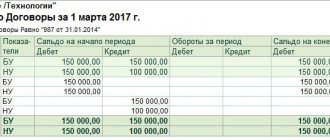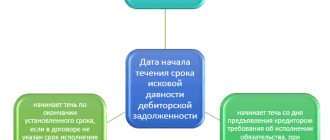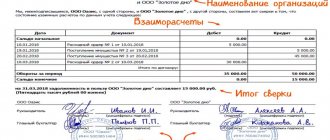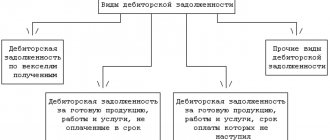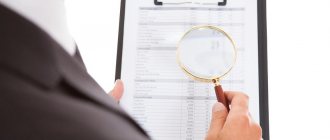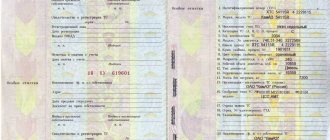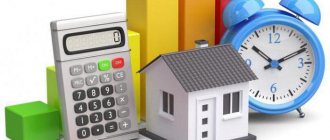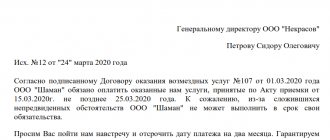Value added tax on acquired assets in the balance sheet (line 1220)
Hello, Vasily Zhdanov is here, in this article we will look at the value added tax on acquired assets. The nightmare of many accountants is VAT.
You have to deal with it not only in current activities and at the time of preparing the declaration, but also when preparing annual reports. The amount of VAT must be reflected in the balance sheet of the enterprise.
Below we will look at how to show the VAT amount in line 1220.
Accounting accounts to display VAT on purchases
VAT is a complex tax and an accountant needs to be very careful when working with it. If a company operates on a common system, then it buys mainly from counterparties that work with VAT. Therefore, the tax on all company purchases in the total amount is the amount of the “input” tax, which usually reduces the amount of VAT transferred to the budget.
It doesn’t matter at all what is purchased for the organization’s activities - stationery or expensive equipment, or maybe a service. If the purchase and sale transaction is completed in accordance with all the rules and you have a full set of original documents, including accounting documents, then VAT can be safely taken into account. The accumulation of tax amounts on purchases is shown in account 19 .
The entire amount of value added tax that comes to the organization along with the purchase of goods, services or other valuables must be very clearly reflected in the accounting accounts. There are three main entries that relate to the “input” tax.
| operations | Wiring | Explanation |
| The amount of tax billed by the seller | D19 K60 | When purchasing a product, service, or value, the buyer pays VAT along with the cost. Its amount is taken into account in account 19 |
| Tax accepted for deduction | D68 K19 | Tax that is subject to deduction from the budget is reflected in credit 19 of account |
| Write-off of VAT amount | D91 K19 | In the event that you have to write off the tax amount, the amount falls to 91 accounts |
Every accountant makes such entries when accounting for VAT on purchases.
It must be remembered that goods can be purchased for their further sale, property related to fixed assets, materials, intangible assets, as well as services. If you have an invoice, VAT from such transactions will be “input” and will ultimately reduce the accrued tax at the end of the quarter.
A little about accounting account 19 for VAT accounting
In order to collect VAT on purchases, account 19 is used. Several sub-accounts are opened for it, which allow you to keep track of VAT analytics on goods, services, intangible assets and other types of purchases.
Such VAT is subject to reflection on account 19 and is accepted for deduction when calculating tax for the quarter.
In order for VAT amounts to be deducted, the following conditions must be met:
- The purchased property must be used in activities subject to VAT
- The company accountant has a correctly executed original invoice in his hands
- The purchased property is registered with the organization
In most cases, there is no balance on account 19. If at the end of the period a credit balance on the account is formed, this means using the opportunity to accept VAT for reimbursement .
If the organization has not received an invoice for the purchase, then after three years the tax amount is written off to account 91.
How to display the VAT amount in the company’s balance sheet
When preparing annual reports, the tax amount can be reflected in the balance sheet on three different lines, both as an asset and as a liability.
Lines 1220, 1230 and 1520 are used for padding.
In the event that for some reason the tax amount cannot be deducted, line 1220 is used. This is a balance sheet asset. There is a possibility that the tax amount reflected here will reduce VAT charges in subsequent periods .
Line 1230 reflects regular accounts receivable, which contains, among other things, the amount of tax. Such debt may arise if, for example, a company makes an advance payment to a supplier. The line is also in the asset.
The only case when the amount of VAT is reflected in the liability is line 1520. It contains information about the amount of tax that the company owes to the budget.
Thus, the VAT amount can act as a resource, or it can be a source of funds.
We'll look at filling out the lines in more detail below.
Formation of line 1220 in the organization’s balance sheet
The tax on purchased assets is reflected in the organization’s balance sheet. This happens if the tax “came to us”, but was not declared to be credited to the budget.
Thus, the formula for calculating VAT on purchased values is very simple: in line 1220 of the balance sheet asset you need to enter the debit balance of account 19.
It must be borne in mind that tax amounts are not deductible if:
- Valuables are purchased that are used in the production or sale of goods (services) that are not subject to VAT.
- Valuables are purchased that are planned to be resold in another state.
- The valuables were acquired by those persons who either did not pay it at all or were exempt from such obligation.
- Valuables were purchased, the sale of which is not considered a sale by law.
- There is no correctly drawn up invoice
- It was decided to apply the deduction in subsequent periods
- The company is a manufacturing company and it takes a long time to produce products, exceeding the scope of one period
The debit balance of account 19 also appears if there are expenses that are subject to rationing. For such expenses, VAT is deductible only within the limits of the standard. It must be remembered that it is possible to find out the exact amount of expenses subject to rationing only based on the results of work for the year.
During the year, it is necessary to constantly adjust the amount of VAT to be deducted, taking into account the applicable standards. Often, at the end of the year, a tax amount is formed that cannot be deducted in accordance with the law. Such amounts are reflected in line 1220 of the balance sheet.
They should be debited from account 19 to 91.
If all VAT at the end of the year is accepted for accounting and there is no debit balance on account 19, then line 1220 does not need to be filled out; a dash must be entered in it.
| IMPORTANT! There will be a balance on account 19 if the company carries out export operations, the production of goods takes a very long time, or an invoice has not been received from the seller. These are the most common reasons for having a balance on the 19th account. There are still some moments when a balance will be present |
It must be borne in mind that if the account balance at the end of the month is very large and this is a significant factor for the organization, then the company has the right to detail the information in line 1220 if it considers it necessary.
An example of calculating and reflecting the tax amount on line 1220 of the balance sheet
Let's imagine a situation where Vasilek LLC purchases materials for a total amount of 120,000 rubles. Let's take a closer look at the purchase price.
As you know, the cost of purchased valuables directly includes the amount for materials and the amount of VAT.
| operations | Posting in accounting | Sum |
| Cost of purchased materials | D10 K60 | 100000 |
| Tax amount in the purchase amount | D19 K60 | 20000 |
| VAT submitted to the budget | D68 K19 | 20000 |
If the company decides to reduce the accrued tax by the amount of “input” VAT, then line 1220 in the balance sheet will not be filled in.
In a situation where, for example, the supplier does not provide an invoice on time for the purchased materials and the amount of tax to be deducted in the current period, then on line 1220 you will need to indicate the amount of VAT equal to 20,000 rubles.
Another nuance is that the tax amount on account 19 can be deducted within three years from the date of the transaction.
Or maybe such a story. Romashka LLC completed an export transaction for the sale of raw materials at the end of December. The amount of VAT in this case was 50,000 rubles.
Such VAT can be deducted, but only after confirmation of the tax rate has been received.
Until this moment, VAT from such a transaction should be taken into account in the debit of account 19, and since there was no confirmation at the end of the year, the tax amount will be reflected in line 1220 of the balance sheet asset.
The amount of VAT reflected in lines 1230 and 1520 of the balance sheet
In addition to line 1220 of the balance sheet asset, VAT can be reflected in two more lines of the report.
- Let's start with the asset. The situation when tax can be reflected in the balance sheet concerns both VAT as part of receivables and the amount of tax as part of transferred advances. Advance payments are a receivable of the organization. They are subject to reflection in Form No. 1 without taking into account tax, which in turn is accepted for reduction. Other types of receivables are reflected on line 1230 including VAT
- Another line where the amount of tax can be reflected is line 1520. It reflects the amount of accounts payable and is part of the liability side of the balance sheet. There is also a peculiarity here. It concerns the receipt of advances and assumes that the amount of advance payments received is reflected without VAT. The rest of the creditor is accounted for as a line item, taking into account tax.
Questions on the topic under consideration
Question 1
The organization is on a simplified system. Is it necessary to fill out line 1220 when preparing annual reports?
Simplified people are a special type of taxpayers. As a rule, they do not work with VAT, however, they may have “input” VAT.
In this regard, the company can establish in its accounting policy the provision that all VAT received with purchases is accounted for in account 19.
In this situation, at the end of the period an account balance will be formed, and when preparing the annual report, this balance will be transferred to line 1220.
Question 2
Can there be the same VAT amounts on lines 1220 and 1520 of the balance sheet?
No, they can't. The coincidence of the meaning of these lines is a pure coincidence, this is an error. Line 1220 is in the balance sheet asset and shows the tax on purchased assets that is not accepted for deduction. Line 1520 is in the liability side and reflects the company’s debt to the budget. There is probably no primary document for the purchase of goods. It is necessary to analyze and identify the error.
Reflecting VAT on the balance sheet is not as simple as it seems at first glance.
Before drawing up the annual report, it is necessary to conduct a thorough check of all indicators, carry out reconciliations with counterparties, take into account the expenses that are accepted according to the standards, and only after that bring the information into the balance sheet.
Since tax amounts can be reflected in both an asset and a liability, it is very important to understand which amount to report in which line. Line 1220 is not always filled in.
Source: https://finzz.ru/nalog-na-dobavlennuyu-stoimost-po-priobretennym-cennostyam-v-balanse-stroka-1220-formula-primer.html
Advances received
Line 1520 “Debt to creditors”
The line “Debt to creditors” (balance sheet liability) summarizes the balances (credit) on the following accounts: 60, 62, 68, 69, 70, 71, 73, 75 and 76, including VAT. These are all the debts of the enterprise that it is obliged to repay within a year, or during the production cycle if it exceeds a calendar year.
IMPORTANT! The amounts of debts to the budget must be verified with the fiscal authorities. It is strictly prohibited to arbitrarily calculate unsettled debts to the budget (clause 74 of the PBU on accounting and accounting in the Russian Federation, approved by order of the Ministry of Finance of the Russian Federation dated July 29, 1998 No. 34n).
When forming line 1520 of the balance sheet, you should take into account a certain nuance with the reflection of advances received. Here there is a situation similar to that of the advances listed. The Russian Ministry of Finance also recommends that advances received be reflected in the balance sheet minus VAT (attachment to the letter of the Russian Ministry of Finance dated January 9, 2013 No. 07-02-18/01).
So on line 1520 you should include:
- accounts payable including VAT,
- advances received minus VAT.
VAT is reflected in the balance sheet as follows:
- in the asset - in two lines (1220 and 1230),
- in the passive - in one line (1520).
The Russian Ministry of Finance advises including in lines 1230 and 1520 receivables and payables for advances minus VAT. Note that the taxpayer has the right to act differently and not deduct the amount of tax from the debt. However, in this case you need to be prepared to argue your position.
How to correctly reflect VAT in management reporting. Part 1 - Balance
When an entrepreneur works with VAT, he buys goods and services both with and without VAT, and sells them only with VAT.
And when the time comes to transfer VAT to the budget, he needs to know whether the business owes the state at the end of the quarter or the state owes the business.
To know the answer to this question and not lose money, you need to correctly reflect everything in your reporting. First of all - in balance. We tell you how.
What you need to know about VAT
1. It is not the entrepreneur who pays VAT, but the buyer. The entrepreneur transfers this money to the state, it is not his initially, the businessman for them is a transit stop.2. VAT does not affect the financial results of a business.
3. Obligations to transfer VAT to the budget must be fulfilled on time. To do this, plan and control them. If you don't plan, you won't have money when it comes time to pay. If we don’t pay on time, the tax office will fine us.
What you need to know about VAT so as not to get caught on your money. Read »
How does a business have VAT obligations?
We have a flower shop. We bought a rose from a farmer, in the price of which the supplier included VAT. We spent 60 ₽, of which 50 ₽ were paid for the rose itself, and 10 ₽ was VAT, which our supplier included in the price of the product.
We loaned this 10 rubles VAT through the supplier to the state - we asked to transfer this money to Vladimir Vladimirovich. He had an obligation to us. We'll settle when we sell.
The VAT that we transferred in advance for Vladimir Vladimirovich is called incoming.
We buy a rose from a farmer, he transfers our part of the VAT to Vladimir Vladimirovich. The VAT, which we transferred in advance to Vladimir Vladimirovich through the farmer, is called incoming for us
When we sell, we receive the VAT paid by the buyer. For us this is output VAT. And we have an obligation to the state to transfer this VAT to the budget within the deadline that it has determined. For the rose we received 120 ₽: 100 ₽ + 20 ₽ VAT. This 20 ₽ is our output VAT.
The VAT that the buyer transferred to Vladimir Vladimirovich through us is called outgoing
And when it comes time to remit VAT, we are not due all the outgoing VAT, but only the difference between it and the incoming one. Outgoing VAT is 20 ₽, incoming VAT is 10 ₽. The difference is 10 ₽. These 10 ₽ are due from us to the budget.
We must transfer to the state not all of the outgoing VAT that we received, but only the difference between it and the incoming
And it also happens that they bought three roses under the same conditions. Thus, through the supplier, Vladimir Vladimirovich received a VAT advance of 30 rubles. And they sold only one - also for 100 ₽ + VAT 20 ₽.
And when at the end of the quarter they come to us from Vladimir Vladimirovich and demand this twenty from us, we answer: “No way, dears! We gave as much as 30 rubles in advance to the Kremlin through a farmer. Remember? And through us the buyer transferred 20 rubles. So it’s not we who owe you 20 rubles, but you who owe us 10 rubles. Therefore, either let this ten dollar lie with you - we’ll settle the deal in the next quarter.
Or drive it back, and start the next quarter from scratch - we also have that right.” The messengers listened to us, picked up the papers, and counted them. We are convinced that we are right. And went home.
Input VAT is VAT included in the cost of goods and services that an entrepreneur purchases for business needs.
Output VAT is VAT that an entrepreneur adds to the cost of his goods and then transfers to the state.
We transfer the difference between incoming and outgoing VAT to the budget if, at the end of the quarter, we still owe the state. And if it is owed to the business, there are two options - get this money back, or let it remain in the budget - then we will settle the matter.
Now let's see how all this is reflected in the balance sheet.
How to reflect VAT liabilities on the balance sheet
1. So, we paid the supplier 60 ₽ for the rose, where 50 ₽ is the cost of the rose and 10 ₽ is VAT. The state now owes us this ten. In reporting language, we acquired two assets - a rose and input VAT.
We bought a rose from a supplier. On the balance sheet: two assets appeared - goods for resale and input VAT. Since input VAT is money that the state owes us, we record it in accounts receivable
2. We sold a rose and received 120 ₽ from the buyer: 100 ₽ is our price for the rose and 20 ₽ VAT, which we added to the price - this is the output VAT. We have an obligation to transfer VAT to the state.
And now we remember - 10 ₽ VAT was already charged when we bought the rose, and the state owed us this ten. This means that we now owe the state only 10 rubles, and not 20 rubles. Therefore, our VAT debt to the state increases by only 10 rubles.
Offsetting incoming and outgoing VAT in the balance sheet: we owe the state not 20, but 10 rubles
3. Finally, we transfer the VAT to the budget on time. Minus 10 ₽ from liabilities.
Balance after we transferred VAT from the sale of roses to the budget: no debts, everyone is happy
When it comes time to pay VAT, we look to see whether we have more incoming or outgoing VAT.
If there is more outgoing VAT than incoming VAT, it means we owe the state and transfer the difference between creditor and debtor to the budget.
If the outgoing VAT is less than the incoming VAT, the state owes us. What to do when it owes us money is the topic of a separate article.
That's all. We've dealt with the most difficult part. Look out for an article soon on how to reflect VAT in the cash flow statement (CFT) and profit and loss statement (P&L).
Business finance diagnostics
Take this quiz to help you understand your company's financial strengths and weaknesses. Based on the test results, they will contact you and tell you which tools to implement first.
Take the test It's free
Source: https://gazeta.noboring-finance.ru/upr-nds-1
ACCOUNTS RECEIVABLE: GENERAL CHARACTERISTICS
Enterprises engaged in economic and financial activities carry out settlements with counterparties.
If an enterprise has shipped products or performed work and services before funds (payments) are received in the current account, then a receivable arises. Accounts receivable is the debt of suppliers and contractors, employees of the enterprise, counterparties-customers who owe the given enterprise for goods, works, and services sold. Debtors can be both legal entities and individuals.
The essence of accounts receivable is that in accounting these debts are considered part of an asset, that is, in fact, they have not yet been paid, but are included in profit. Consequently, the state of accounts receivable affects the financial position of the enterprise.
The task of any enterprise is constant monitoring and analysis of accounts receivable. To solve this problem, you need to generate reports on the status of debts, their size and composition.
Composition of accounts receivable:
- debt on advances issued to suppliers for upcoming deliveries;
- debt on settlements with accountable persons;
- debt of contracting parties-buyers for payments for goods, work performed, services rendered;
- overpayment of taxes to the budget;
- calculations for “input” VAT;
- debt of insurance contributions from the social insurance fund (FSS), if the amount of benefits for sick leave and in connection with maternity exceeds the accrued insurance contributions;
- debt on loans issued;
- debt in settlements with persons who must compensate for damage;
- other debt to the company.
How to correctly reflect VAT in management reporting. Part 1 - Balance
When an entrepreneur works with VAT, he buys goods and services both with and without VAT, and sells them only with VAT.
And when the time comes to transfer VAT to the budget, he needs to know whether the business owes the state at the end of the quarter or the state owes the business.
To know the answer to this question and not lose money, you need to correctly reflect everything in your reporting. First of all - in balance. We tell you how.
What you need to know about VAT
1. It is not the entrepreneur who pays VAT, but the buyer.
The entrepreneur transfers this money to the state, it is not his initially, the businessman for them is a transit stop.2. VAT does not affect the financial results of a business.3. Obligations to transfer VAT to the budget must be fulfilled on time. To do this, plan and control them. If you don't plan, you won't have money when it comes time to pay. If we don’t pay on time, the tax office will fine us. What you need to know about VAT so as not to get caught on your money.
Read »
How does a business have VAT obligations?
We have a flower shop. We bought a rose from a farmer, in the price of which the supplier included VAT. We spent 60 ₽, of which 50 ₽ were paid for the rose itself, and 10 ₽ was VAT, which our supplier included in the price of the product.
We loaned this 10 rubles VAT through the supplier to the state - we asked to transfer this money to Vladimir Vladimirovich. He had an obligation to us. We'll settle when we sell.
The VAT that we transferred in advance for Vladimir Vladimirovich is called incoming.
We buy a rose from a farmer, he transfers our part of the VAT to Vladimir Vladimirovich.
The VAT, which we transferred in advance to Vladimir Vladimirovich through the farmer, is called incoming for us
When we sell, we receive the VAT paid by the buyer. For us this is output VAT.
And we have an obligation to the state to transfer this VAT to the budget within the deadline that it has determined. For the rose we received 120 ₽: 100 ₽ + 20 ₽ VAT. This 20 ₽ is our output VAT.
The VAT that the buyer transferred to Vladimir Vladimirovich through us is called outgoing
And when it comes time to remit VAT, we are not due all the outgoing VAT, but only the difference between it and the incoming one. Outgoing VAT is 20 ₽, incoming VAT is 10 ₽. The difference is 10 ₽. These 10 ₽ are due from us to the budget.
We must transfer to the state not all of the outgoing VAT that we received, but only the difference between it and the incoming
And it also happens that they bought three roses under the same conditions. Thus, through the supplier, Vladimir Vladimirovich received a VAT advance of 30 rubles.
And they sold only one - also for 100 ₽ + VAT 20 ₽. And when at the end of the quarter they come to us from Vladimir Vladimirovich and demand this twenty from us, we answer: “No way, dears! We gave as much as 30 rubles in advance to the Kremlin through a farmer. Remember? And through us the buyer transferred 20 rubles.
So it’s not we who owe you 20 rubles, but you who owe us 10 rubles. Therefore, either let this ten dollar lie with you - we’ll settle the deal in the next quarter. Or drive it back, and start the next quarter from scratch - we also have that right.” The messengers listened to us, picked up the papers, and counted them.
We are convinced that we are right. And went home.
Input VAT is VAT included in the cost of goods and services that an entrepreneur purchases for business needs. Output VAT is VAT that an entrepreneur adds to the cost of his goods and then transfers to the state.
We transfer the difference between incoming and outgoing VAT to the budget if, at the end of the quarter, we still owe the state. And if it is owed to the business, there are two options - get this money back, or let it remain in the budget - then we will settle the matter.
Now let's see how all this is reflected in the balance sheet.

